
Choosing ESD Flooring for Electronics Handling and Manufacturing Applications
[22 min read]
Post Sections
Standards for ESD floors in electronics manufacturing and handling services (EMS) are stringent. Learn how to choose the best ESD floor for your space.
Need additional information about specific ESD products? Visit our product section.
Electronics industry flooring applications—including electronics manufacturing facilities, microelectronics fabrication, circuit board assembly, box build, electronics test and repair, cleanrooms, labs and R&D facilities—have more stringent static-control requirements than do most other applications.
Electronics with highly sensitive microcircuits are particularly susceptible to damage caused by the sudden spike in electrical current that results from random static discharge. The protocols set by the ESD Association, in their standard ANSI/ESD S20.20, were created for these spaces.
Choosing the Right ESD Floor
- Provide a traceable path to ground of less than or equal to 1 billion ohms (≤ 1.0 x 10E9);
- Prevent static charges in excess of 100 volts (< .1 kV) from accumulating as people walk (called walking body voltage).
Path to Ground
In ESD floors, conductive elements, such as carbon particles or carbon fibers, are added during the manufacturing process. These conductive elements transport static away from the surface of the floor, through its thickness, across a unifying conductive underlayment, to ground.
Every floor, regular as well as ESD, has some degree of electrical resistance. In lay terms, all floors stop, or resist, a certain amount of static electricity from taking its natural path to ground. The goal is to choose an ESD floor with enough conductivity to provide an effective path to ground, and enough electrical resistance to meet safety requirements and protocols for working with or near energized equipment.
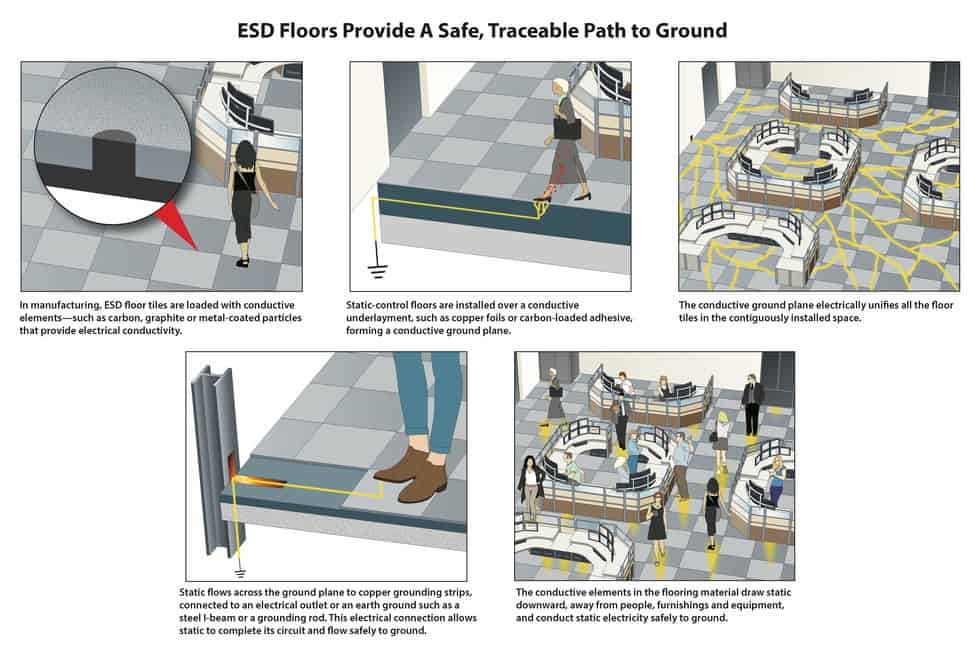

Measuring Electrical Resistance
We can predict how quickly or slowly an ESD floor will ground static charges by measuring its electrical resistance. Resistance is measured in ohms, using test method ANSI/ESD STM7.1-2013. Individual tiles should be tested to measure the rate at which current passes across the surface of the floor. To be sure the floor will meet expectations after it’s installed, a mockup installation should also be tested, with tiles glued with conductive adhesive to a substrate like plywood.
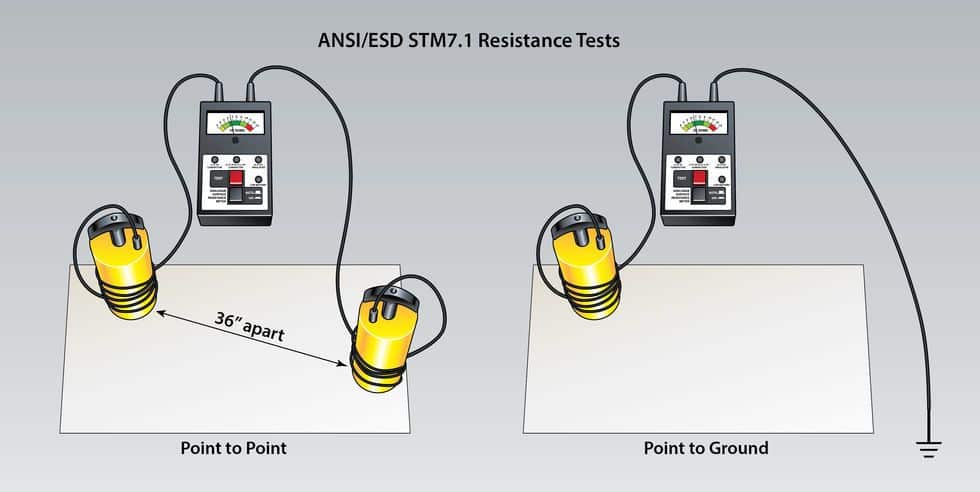

As we know, water is a conductor. At 40% RH, airborne moisture will affect and likely improve the performance of any ESD floor. In temperature-controlled environments, where the air is typically drier, floors will generally have higher resistance readings. This is why it’s important to test at low RH.
Before testing, both the flooring tiles and mockup sample should be placed in a controlled chamber for several days with the humidity lowered to 12% RH. This removes any moisture from the flooring material and eliminates humidity as a variable in assessing performance.
Finding the "Sweet Spot"
ESD S20.20 requires only that floors in electronics spaces measure below 1.0 x 10E9 ohms.
A floor with readings at the high end of the range—over 1 x 10E8—may be too resistant: in combination with footwear, the floor may not transport static charges quickly enough to prevent damaging static events.
If the floor is too conductive—below 1 x 10E5—electricity from energized equipment and machines could flow too quickly, potentially putting people at risk.* In certain circumstances—if someone were servicing or inspecting a mainframe server, for example—a highly conductive floor could increase the potential for electrical safety hazards.
* In end-user spaces with electrified equipment in use—e.g., 24/7 mission-critical call centers, dispatch operations, flight towers—where people are not required to wear special ESD-protective footwear, floors with resistance below 1.0 x 10E6 do not meet electrical standards. In electronics manufacturing and handling operations conductivity is much less of an issue. That’s because the built-in resistors in ESD footwear, which everyone in the space is required to use, provide protection against electrical shocks.
The goal is to find the “sweet spot,” with static electricity flowing at just the right speed.
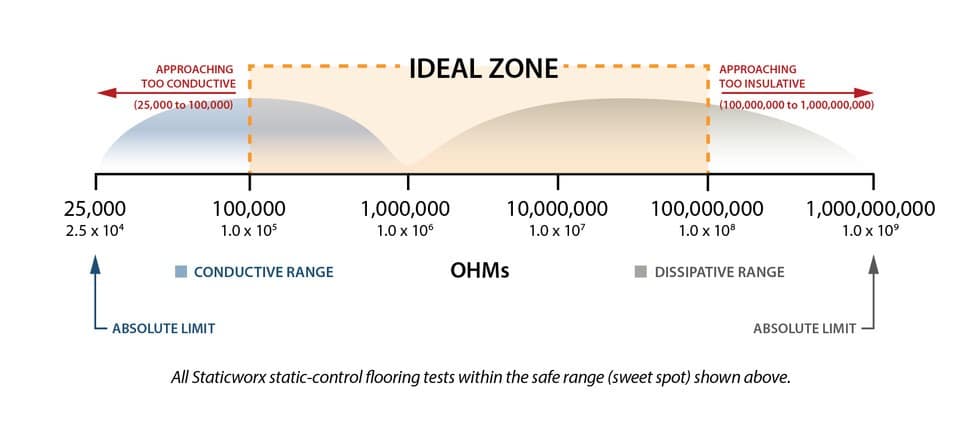

The “sweet spot,” or ideal resistance, is not an absolute number. Rather, it’s a range—i.e., between 1.0 x 10E5 and 1.0 x 10E8 ohms (or between 100,000 and 100,000,000 ohms).
Charge Generation: The Flooring Footwear Combination
Some people mistakenly believe if a floor is conductive, it is also antistatic, or low-charge generating.
Not true.
Charge generation is, in part, a property inherent in the flooring material and in part due to the interaction between the flooring and the footwear worn by people walking on the floor.
Inherent charge generation capacities can be attributed to the chemical makeup of a material, or a result of the manufacturing process. Because the triboelectric propensity of rubber is similar to that of most shoe soles, electrically conductive (EC) rubber is a naturally low charge-generating material.
Independent research and laboratory tests have shown conductive rubber to be the only ESD flooring material that inhibits static without the use of special ESD footwear. Note: ESD footwear may be required to adequately protect ESD-protected areas [EPA] or Class 0 applications with extremely low ESD thresholds.
ESD vinyl and epoxies, on the other hand, are made from polymer-based recipes that generate static. These base resins and polymers are exactly the same as those used in standard—insulative—static generating vinyl and epoxy floors. Conductive additives like fibers, particles and carbon veins, are incorporated into these ordinary materials to create a conductive path from the floor surface to ground.
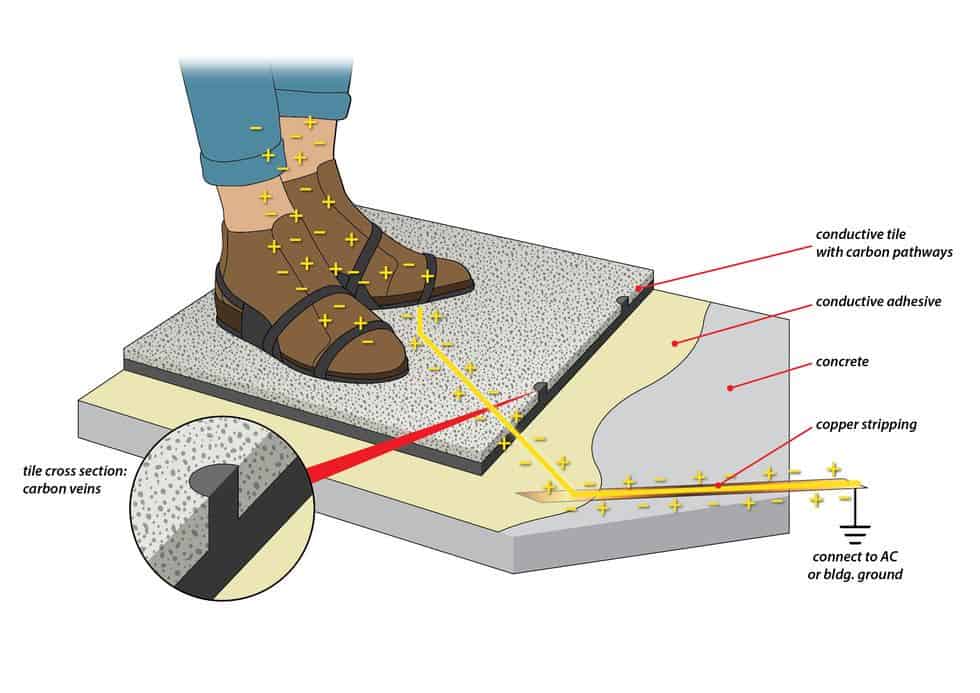

Because of their relatively low density, the conductive additives represent a minimal portion of the overall surface area on vinyl and epoxy flooring. For the most part, a person walking on these floors is making contact with the insulative base materials. This means that when a person walks on these types of floors they are generating static—tribocharging—just as they would when walking on ordinary floors.
Vinyl & Epoxy with ESD Footwear
The only way to prevent static on an ESD vinyl or epoxy floor is by mandating the use of special, ESD footwear—i.e., heel, toe or sole straps or ESD shoes. In fact, ESD vinyl and epoxy floors are designed for use with static-protective footwear.
The conductive elements in ESD footwear form an electrical bridge between the wearer’s skin and the embedded conductive fibers or filaments in the floor, preventing static buildup and discharging static to ground.

ESD footwear will drain static at the same rate as it is generated—as long as the footwear makes proper electrical contact with the conductive additives in the floor. In some cases, contact between the footwear and conductive fibers in the floor may be insufficient to properly drain static charges. If the ESD footwear has a small surface area, for instance, it may not make proper electrical contact with the floor. Most people lift one foot as they walk. Given the tiny conductive surface on a heel or toe strap, the foot on the ground could easily overstep the conductive fibers in the floor, preventing static from discharging to ground.
Due to tribocharging, static-dissipative vinyl and certain ESD epoxy coatings perform poorly even when used with some ESD footwear. The only way to know if a floor will prevent static from accumulating is, first, to determine what types of footwear will be worn in the environment. Second, to test a sample installation prior to installing the floor, per STM97.2, with the test subject wearing each type of footwear to be worn in the space (ESD and non-ESD, if applicable).
Most electronics facilities have protocols in place requiring all personnel to wear ESD footwear. If protocols are not in place—or not enforced—specifiers should select a floor that will prevent and inhibit static regardless of the type of footwear people choose to wear in the environment.
Not all footwear is created alike.
Static generation depends, not only on the flooring material, but the shoes people wear in the space. Leather is a naturally low-charge generating material due to its unique triboelectric properties and tendency to absorb moisture, such as ground water or sweat*; for this reason, shoes with leather soles tend to generate less static than most other types of street shoes.** Hiking shoes with electrically insulative polyurethane soles, on the other hand, generate greater static charges than other street shoes.
* At lower humidity ranges, leather is not always anti-static, so when evaluating ESD flooring, it’s important to consider environmental factors, along with footwear and flooring material.
** Leather shoes generate too much static to meet the body voltage limits for ANSI-certified electronics manufacturing and handling.

ESD footwear will drain static at the same rate as it is generated—as long as the footwear makes proper electrical contact with the conductive additives in the floor. In some cases, contact between the footwear and conductive fibers in the floor may be insufficient to properly drain static charges. If the ESD footwear has a small surface area, for instance, it may not make proper electrical contact with the floor. Most people lift one foot as they walk. Given the tiny conductive surface on a heel or toe strap, the foot on the ground could easily overstep the conductive fibers in the floor, preventing static from discharging to ground.
Due to tribocharging, static-dissipative vinyl and certain ESD epoxy coatings perform poorly even when used with some ESD footwear. The only way to know if a floor will prevent static from accumulating is, first, to determine what types of footwear will be worn in the environment. Second, to test a sample installation prior to installing the floor, per STM97.2, with the test subject wearing each type of footwear to be worn in the space (ESD and non-ESD, if applicable).
Most electronics facilities have protocols in place requiring all personnel to wear ESD footwear. If protocols are not in place—or not enforced—specifiers should select a floor that will prevent and inhibit static regardless of the type of footwear people choose to wear in the environment.
Not all footwear is created alike.
Static generation depends, not only on the flooring material, but the shoes people wear in the space. Leather is a naturally low-charge generating material due to its unique triboelectric properties and tendency to absorb moisture, such as ground water or sweat*; for this reason, shoes with leather soles tend to generate less static than most other types of street shoes.** Hiking shoes with electrically insulative polyurethane soles, on the other hand, generate greater static charges than other street shoes.
* At lower humidity ranges, leather is not always anti-static, so when evaluating ESD flooring, it’s important to consider environmental factors, along with footwear and flooring material.
** Leather shoes generate too much static to meet the body voltage limits for ANSI-certified electronics manufacturing and handling.

As we know, static generation results from frictional contact between the flooring material and footwear. A floor that generates under 100 volts of static on a person wearing conductive full-sole grounders could generate charges well above 100 volts on a person wearing basic heel straps or static-dissipative shoes. Ordinary street shoes—non-ESD footwear—would generate significantly more static, showing far more risk. That’s why, when testing the electrical properties of ESD flooring options, it’s imperative to evaluate the materials for compatibility with all types of footwear people will use in the space.
For ESD-protected areas, it’s a good practice (recommended) to narrow footwear selections and perform both system resistance (97.1) and charge generation (97.2) tests with the test subject wearing the exact footwear specified for the space. If heel straps are specified, the subject should wear heel straps. If heel straps and ESD shoes will be allowed, conduct two tests, one with heel straps, one with the specified ESD shoes.
It’s also important to know what would happen if people did wear non-ESD footwear in the space—or wore different types of ESD footwear than mandates require—e.g. toe rather than heel straps or heel straps rather than ESD shoes)—and to plan accordingly.
✓ visual selector guide;
✓ walking body voltage/low static generation;
✓ resistance requirements and testing;
✓ ESD flooring comparison;
✓ industry standards & test methods;
✓ key ESD terms
Measuring Walking Body Voltage
To meet the parameters for charge generation outlined in ANSI/ESD S20.20, we test Walking Body Voltage, measured in volts, using test method ANSI/ESD STM97.2.
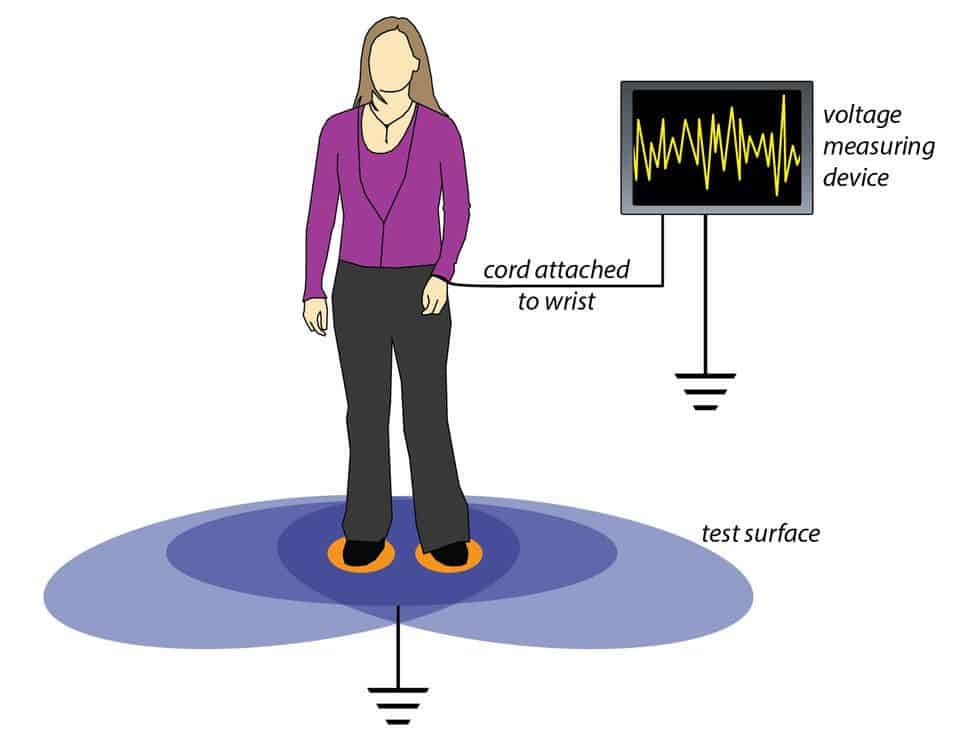

STM97.2 tests the entire system—person, footwear and floor. To determine the compatibility of the flooring/footwear combination, the test should be conducted multiple times, with the subject wearing each type of footwear likely to be worn in the environment. The results must confirm charge generation of < 100 volts of static when the subject walks on the floor.


For flooring intended for use in spaces handling Class 0 components, or where ultra-sensitive electronics are manufactured, assembled, or handled, the system should ideally generate < 20 volts of static electricity.
Test Results Comparing Charges Generated by Heel Straps and ESD Shoes on Different Types of Floors


A warranty stating compliance with ANSI/ESD S20.20 is not sufficient to ensure that an ESD floor will perform properly.
What Does It Mean When Someone Says a Floor "Meets ANSI/ESD S20.20"?
When discussing the electrical properties of their static-control floors, manufacturers usually refer to ANSI/ESD documentation, stating that their floor “meets ANSI/ESD S20.20.”
What they mean is, in resistance testing, their floors measure under 1.0 x 10E9 ohms. Because it’s out of context, this claim is misleading: a floor does not meet the electrical parameters of ANSI/ESD S20.20 based solely on resistance readings: resistance is only one part of a bigger picture.
First, the flooring material is a single component in the flooring-footwear system. ANSI requires testing the resistance of the flooring material (per STM 7.1) as well as the resistance of the flooring system (per STM 97.1). Using a mockup installation, S97.1 measures the resistance to ground, from the test subject, wearing whatever footwear will be worn in the space, through the flooring material, to the underlying adhesive, to ground.
The resistance of a flooring material alone can differ from system resistance. System resistance accounts for all elements in the system, and can never be lower than the most resistant element in the chain. If the adhesive is less conductive (more resistant) than the flooring material, for instance, the resistance of the system will measure higher than that of the flooring material—masking potential performance issues or risks associated with overly conductive floors. The only way to spot differences is to measure both material (point to point) resistance and system (point to ground) resistance.
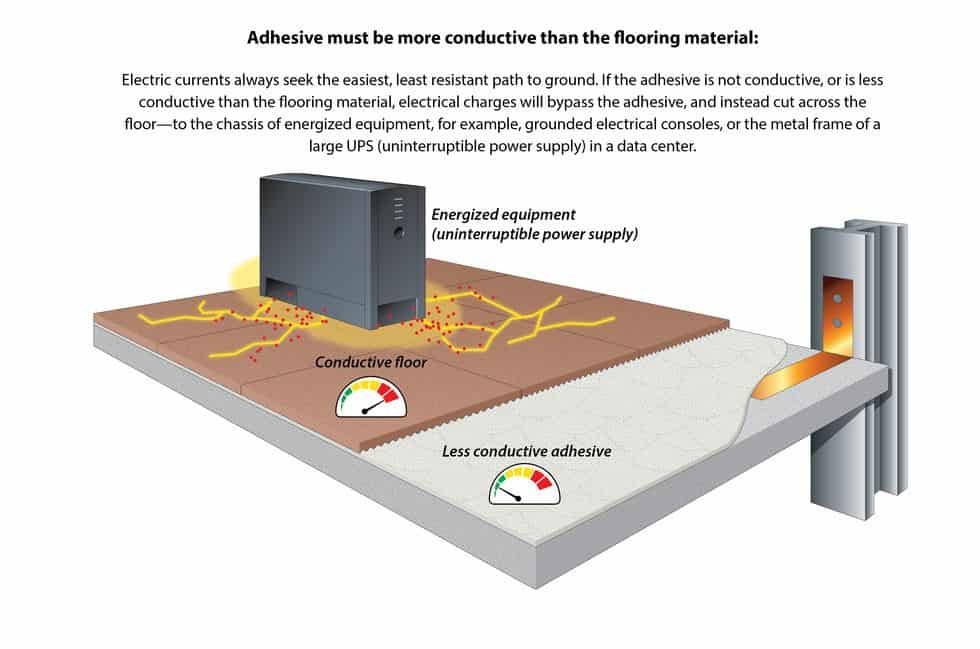

Second, even if both resistance measurements—material and system—meet the recommended parameters, the floor has only met half the requirements of S20.20. The S20.20 standard also requires body voltage testing.
Charge Generation: Then and Now
To meet older versions of ESD S20.20, a floor had to pass only electrical resistance tests. At the time, the resistance of a floor was thought to predict its propensity for charge generation. That is, if resistance tested within a certain range, it was assumed that the floor would discharge static quickly enough to prevent charges—called walking body voltage—from accumulating when people walked.
We now know that conductivity (measured as a low resistance reading) does not prevent charge generation. Studies have shown that some ESD floors—dissipative or conductive—can generate enough static to harm static-sensitive electronics. In 2014, as a reflection of this new knowledge, ANSI changed the standard to include both resistance and body voltage testing.
To comply with ANSI/ESD S20.20, electrical resistance must measure ≤ 1 x 10E9 ohms AND—tested in combination with the various types of footwear that will be used in the space—the floor must not generate static charges in excess of 100 volts.
What Are the ANSI/ESD S20.20 Requirements?

In fact, S20.20 references not one, but three standard test methods, listed below.
The first two methods test resistance properties, measured in ohms. The third, measured in volts, tests walking body voltage, or charge generation—crucial in determining the functionality of an ESD floor.
Independent lab testing of fiber-loaded, self-leveling epoxy floors proved that a floor can generate 100s of volts of static on a person wearing ESD heel straps—even when the floor measures in the conductive range. At 100 volts+, static could destroy components the floor is meant to protect. That’s the reason ANSI/ESD S20.20 requires all three tests.
ANSI/ESD STM7.1
Floor Materials—Resistive Characterization of Materials. This standard says that flooring material must measure below 1.0 x 10E9 ohms to ground. The flooring material must also comply with the 2 parameters listed below:
ANSI/ESD STM97.1
Floor Materials and Footwear—Resistance in Combination with a Person. The recommended maximum system resistance is 1 x 10E9 ohms.
Technically, flooring does not meet S20.20. That’s because ANSI/ESD S20.20 is not a specification. It’s a process document. A floor meets (or doesn’t meet) the recommended electrical parameters derived from the standard test methods referenced in S20.20.
In fact, S20.20 references not one, but three standard test methods, listed below.
The first two methods test resistance properties, measured in ohms. The third, measured in volts, tests walking body voltage, or charge generation—crucial in determining the functionality of an ESD floor.
Independent lab testing of fiber-loaded, self-leveling epoxy floors proved that a floor can generate 100s of volts of static on a person wearing ESD heel straps—even when the floor measures in the conductive range. At 100 volts+, static could destroy components the floor is meant to protect. That’s the reason ANSI/ESD S20.20 requires all three tests.
ANSI/ESD STM7.1
Floor Materials—Resistive Characterization of Materials. This standard says that flooring material must measure below 1.0 x 10E9 ohms to ground. The flooring material must also comply with the 2 parameters listed below:
ANSI/ESD STM97.1
Floor Materials and Footwear—Resistance in Combination with a Person. The recommended maximum system resistance is 1 x 10E9 ohms.
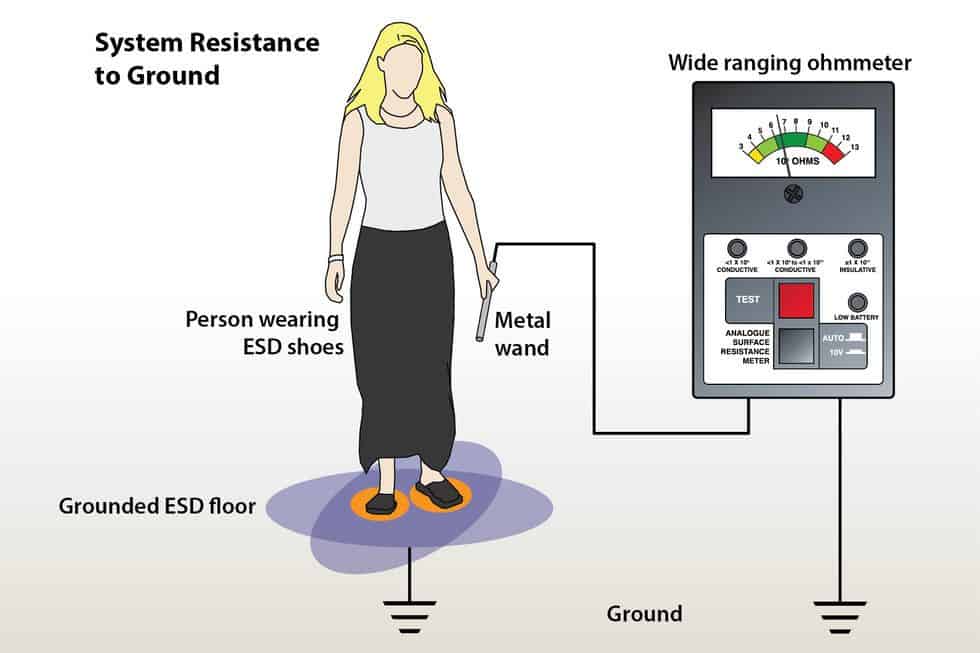

ANSI/ESD STM97.2
Floor Materials and Footwear Voltage Measurement in Combination with a Person. The recommended maximum voltage allowed is 100 volts.
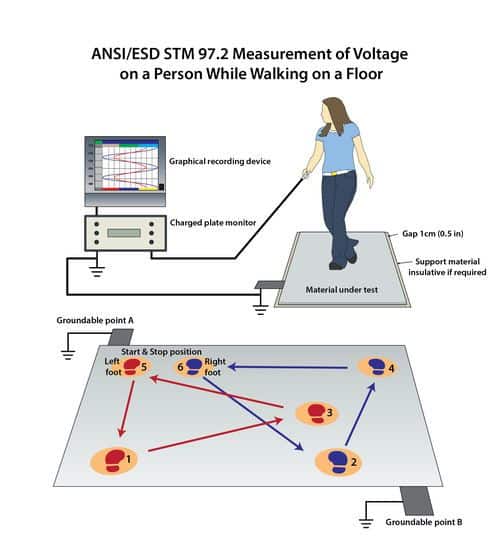
Why Some Static-Control Floors May Not Meet ANSI/ESD S20.20
System resistance, measured through a person and footwear, yields a different value than testing the resistance of the flooring material alone, using 5-pound NFPA probes.
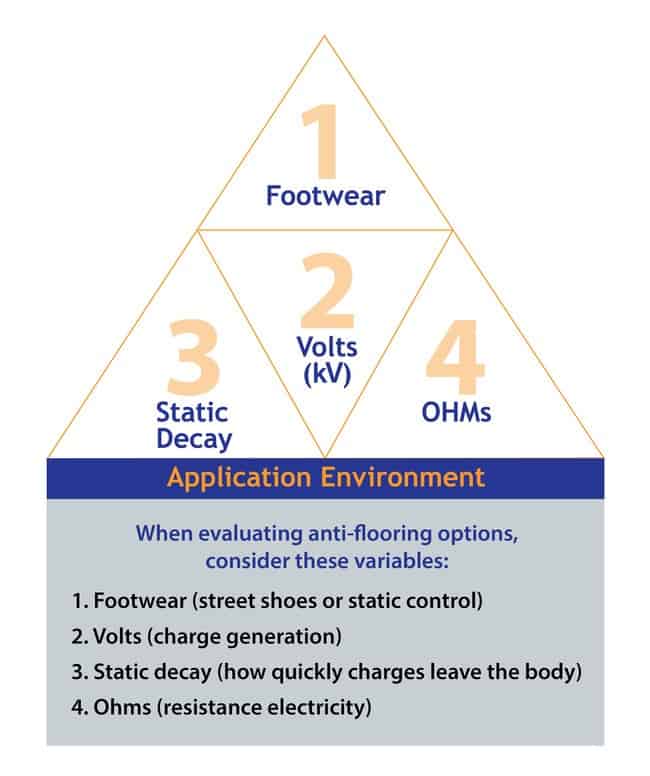
Let’s assume the flooring material measures 1 x 10E8, within the acceptable resistance range. For the system resistance test, the person, standing on that same floor, is wearing static-dissipative shoes. It would be difficult—if not impossible—for a flooring material measuring 1.0 x 10E8, combined with footwear that’s also in the upper end of the resistance range, to be part of a total system measuring less than 1 x 10E9. The math just doesn’t work.
Again, most static-dissipative coatings—and some conductive floors—cannot prevent body voltages from exceeding 100 volts. Since the goal of ANSI/ESD S20.20 is to prevent body voltages above 100 volts, it is impossible to categorically state that all static-dissipative and conductive floors measuring less than 1.0 x 10E9 meet ANSI/ESD S20.20. In fact, it is highly unlikely.
The Best and Worst Floors for Electronics Manufacturing and Handling
Ideal, Best Practice Use
Static-dissipative carpet tile: With proper footwear, meets all parameters of ANSI/ESD S20.20. Static-dissipative carpet inhibits static regardless of footwear. Easy installation. Sound-deadening ergonomic surface. Can be installed as a floating and movable floor without any adhesive.
Material cost is approximately $4.50-$5.50 per square foot.
Disadvantage: Soft surface, not suitable for certain wet process areas in electronics manufacturing.
Rubber tile and sheet flooring: With proper footwear (based on the ESD requirements for the application), rubber tile and sheet flooring meet all parameters of ANSI/ESD S20.20. Independent research and laboratory tests have shown EC (conductive) rubber to be the only ESD flooring material that inhibits static generation regardless of footwear. Rubber looks great and wears well. Because it’s easy to clean and maintain, total cost of ownership is low.
Material cost is approximately $8.00-$10.00 per square foot.
Disadvantage: High initial cost.
Use ONLY if Everyone on the Floor is Required to Wear Antistatic Footwear
Conductive vinyl: Meets all parameters of ANSI/ESD S20.20—with most static-control footwear. Vinyl shines to a high gloss, wears well and is resistant to dirt and stains from messy operations or chemical spills.
Material cost is approximately $4.00-$5.00 per square foot.
Disadvantage: Conductive vinyl is not a low static-generating material; this means it won’t prevent static from building on people as they walk (walking body voltage). Without the use of static-control footwear options, like heels straps or booties, a conductive vinyl floor will actually generate static events.
Conductive and Dissipative Epoxy: Like ESD vinyl, conductive and dissipative epoxies offer little to no static control with regular footwear. When considered for ANSI/ESD S20.20 applications, epoxies should always be tested for charge generation with the exact ESD footwear that will be used. Some ESD epoxy tests well with full-coverage ESD footwear but poorly with ESD foot straps. At its best, ESD epoxy provides the same static-control performance as a high-quality ESD vinyl floor.
The best formulations consist of two layers: a) an insulating primer and b) a conductive top coat. The least effective ESD epoxy floors require a three-layer formulation that includes a black conductive ground plane directly under the top coat. These three-layer systems almost always pass the resistance test (ohms) and fail the ANSI/ESD S97.2 walking voltage test (volts.)
Material cost ranges from as little as $1 sq./ft. for an inexpensive paint coat, to $5 sq./ft. for a multi-layer self-leveling floor.
Advantages: High gloss, easy rolling of heavy loads, low maintenance, reasonable cost, no seams.
Disadvantages: the installer determines the appearance and the electrical performance, three-layer systems do not pass the latest ANSI/ESD performance standards, and you don’t know what you have until after the floor has been installed and the installation has cured.
Not recommended
Conductive materials measuring below 2.5 x 10E4—or 25,000—ohms.
While infrequent, some composite floors that measure below 1.0 x 10E5, particularly conductive carpet, could expose workers, working on or near operational equipment, to an unnecessary, low-resistance path to ground. If a worker, standing or kneeling on an overly conductive floor, were inadvertently to come into contact with live electricity—through a short circuit, for instance—the current, seeking a path to ground, could flow through the person to the floor, and he or she could receive a dangerous shock.
Recent independent testing revealed that a conductive carpet can support dangerous AC electrical currents as great as 50 milliamps. To put this number in perspective, any current over 10 milliamps can produce a painful to severe shock.*
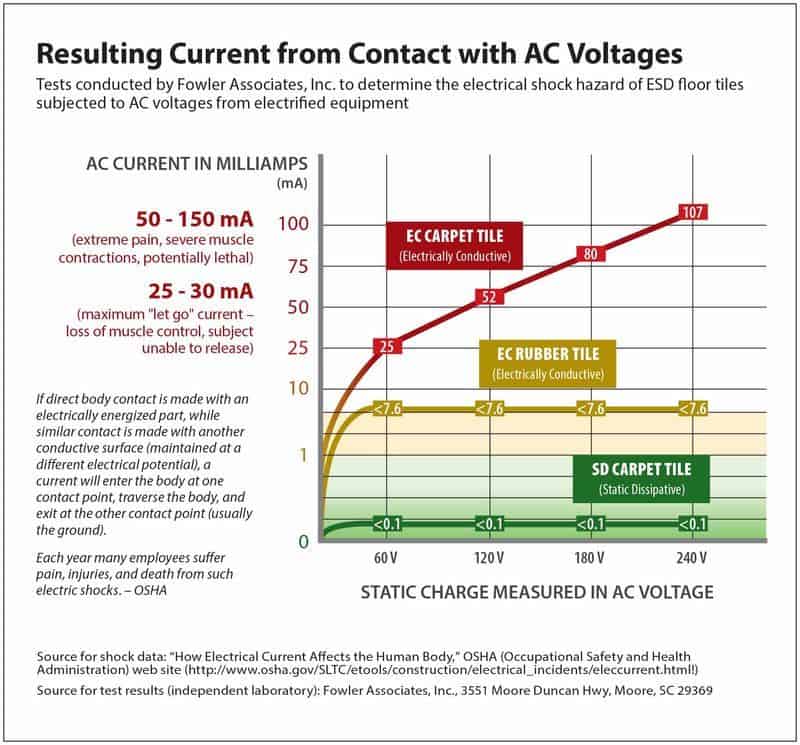

Checklist: Choosing the Right Static-Control Flooring
- Static-control floors should be tested with an ohm meter to determine their electrical resistance. If the material tests above 1 x 10E9, it cannot be grounded.
- Only static dissipative and conductive floors can be grounded.
- Standard flooring installed with ground strips or conductive adhesive will not offer any static protection.
- The floor must pass the Walking Body Voltage test, showing that it will prevent static buildup in real-world conditions, with every type of footwear to be worn in the environment.
- When in doubt, ask for verification using independent lab test data. If ESD footwear is not mandated or if controls are not in place to enforce the mandate, the verification should include data from tests performed on multiple types of ordinary footwear.
- Static-control floors should never require any antistatic sprays or waxes to enhance or maintain static-control performance.
- Static-dissipative properties should be achieved by the physical composition of the material—not by a maintenance additive.
- The floor should reduce static electricity regardless of relative humidity.
- Ask the supplier specifically for ANSI/ESD test data in very dry conditions.
- Never assume that a shock-free environment means a static-free environment.
- A shock-free environment only means static charges are below 3500 volts.
- A charge as low as 20 volts can damage or destroy the sensitive microcircuits inside electronic components.
- A shock-free environment only means static charges are below 3500 volts.
- Require a performance test and written certification for the static-control performance of your finished installation.
- Even if your present electronics are not Class 0 sensitive, if at some point in the future they may be upgraded to Class 0 or you work with state-of-the-art equipment, Class 0 protocols should be considered. As with any potential security breach, it is always best to plan ahead.
With proper planning, you can find an ESD floor that offers adequate protection against the invisible threat of static electricity and damage from ESD discharge, providing peace of mind.
* For information on electrical current or to put numbers into perspective, please see “Fatal Current,” posted by the physics department at Ohio State University.
Get in Touch
The form below will help us better understand your needs and get you as quickly as possible to the right person. We look forward to helping you solve your static problem!
You can expect a response within 24 hours. For faster service, please give us a call: 617-923-2000
"*" indicates required fields
Visit our privacy policy to find out how we process data.
Learning Center Articles
- ESD Basics
- Installation & Maintenance
- Selecting & Specifying an ESD Floor
- Technical Information
- 7 Common Mistakes Selecting an ESD floor
- A Guide to ESD Flooring Selection
- Avoid Costly Failures: What You Need to Know When Specifying ESD Flooring
- Choosing ESD Flooring for:
- ESD Footwear: What Is It and When Is It Necessary?
- ESD Footwear for Electronics Manufacturing and Handling Applications
- Facility Managers’ Guide to Selecting ESD Flooring
- The Need for Due Diligence in Specifying Static-Free Flooring
- Standard of Care for Specifying Floors in Mission-Critical Spaces
- Understanding the Hidden Costs of ESD Flooring

StaticWorx high-performance static-control floors protect electronic components, explosives, and high-speed computers from damage caused by static electricity. ESD flooring is part of a system. Choices should always be based on objective, researched evidence. When you partner with us, we look at all possible items that may need to integrate with the floor, and, focusing on your goals and objectives, help you find the right floor for your application.












